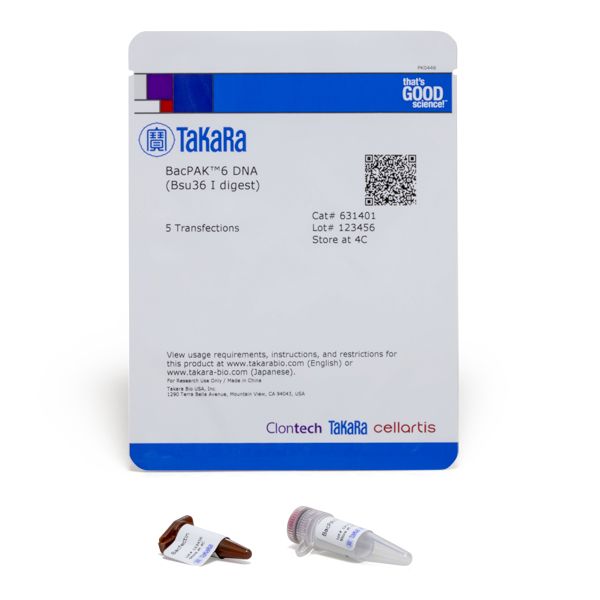BacPAK Baculovirus Expression System
BacPAK Baculovirus Expression System
BacPAK™ Baculovirus Expression System
Complete kit for expressing recombinant proteins at high levels. The BacPAK System uses the baculovirus Autographa californica nuclear polyhedrosis virus (AcMNPV) to produce target proteins in insect cells. More than 90% of the viruses produced by the transfected cells carry the target protein. The expressed recombinant protein is similar in structure, biological activity, and immunological reactivity to the naturally occurring protein because insect host cells provide post-translational processing similar to that of mammalian cells.
BacPAK™6 DNA (Bsu36 I digest)
Baculovirus DNA specially designed and prepared to give a high proportion of recombinant viral expression vectors. The Bsu36 I-digested BacPAK6 DNA is ready-to-use and is sufficient for 5 transfections. The transfection reagent Bacfectin is also provided.
X-GLUC
Substrate for β-glucuronidase, an acid hydrolase encoded by the gusA gene. When used in histochemical assay methods, X-GLUC will give a blue precipitate in the presence of β-glucuronidase.
Overview
- Yields up to 1 g of protein per liter of culture
- Recombinant efficiency >90%
- Proper protein folding
- Expression of biologically active proteins
- Eukaryotic posttranslational modification
Applications
- Recombinant protein expression in insect host cells
BacPAK6 Viral DNA map

BacPAK6 Viral DNA map.
Protein production from recombinant viruses generated using the BacPAK Baculovirus Expression System

Protein production from recombinant viruses generated using the BacPAK Baculovirus Expression System. Recombinant viruses were obtained by cotransfection of transfer vectors with BacPAK6 Viral DNA (Bsu36 I digest), followed by amplification in Sf21 cells. The SDS PAGE analysis of cellular lysates was performed 48 hr after infection of the Sf21 cultures. Lane 1: uninfected Sf21 cells. Lane 2: Sf21 cells infected with wild-type AcMNPV virus. Lane 3: Sf21 cells infected with nonrecombinant BacPAK6 virus. Lane 4: Sf21 cells infected with BacPAK8-GUS recombinant virus. Lane 5: purified CAT protein. Lane 6: Sf21 cells infected with BacPAK9-CAT recombinant virus. Lane M: molecular weight marker.
The In-Fusion Ready BacPAK Vector Set and Baculovirus Expression System

The In-Fusion Ready BacPAK Vector Set and Baculovirus Expression System. A PCR fragment containing your gene of interest is simultaneously and directly cloned into the In-Fusion Ready BacPAK Vector pair to generate N- and C-terminal-tagged constructs. Verified clones are then cotransfected with BacPAK6 viral DNA into insect cells to initiate recombination via the AcMNPV sequences, and replication of recombinant virus. Following virus amplification, infection of insect cell cultures produces recombinant protein, which is then purified by TALON technology.
Insect cells infected with a recombinant baculovirus express the Aequorea coerulescens green fluorescent protein (AcGFP1)

Insect cells infected with a recombinant baculovirus express the Aequorea coerulescens green fluorescent protein (AcGFP1). An In-Fusion Ready BacPAK vector was used to generate a recombinant baculovirus harboring an N-terminal tagged expression construct for the Living Colors fluorescent protein, AcGFP1. Sf9 cells infected with the virus expressed high levels of AcGFP1 and became highly fluorescent. Analysis by flow cytometry revealed that the mean fluorescence intensity of the infected cells was approximately 440-fold greater than that of the uninfected control.
Insect cells express N- and C-tagged Aequorea coerulescens green fluorescent protein (AcGFP1)

Insect cells express N- and C-tagged Aequorea coerulescens green fluorescent protein (AcGFP1). In-Fusion Ready BacPAK vectors were used to generate recombinant baculoviruses harboring N- or C-terminal-tagged AcGFP1 expression constructs. Insect cells (Sf9) infected with either virus express AcGFP1 and thus appear green when viewed by fluorescence microscopy. Panel A. BacPAK-Nterm-6xHN-AcGFP1. Panel B. BacPAK-Cterm- 6xHN-AcGFP1


